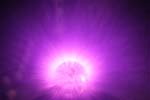|
Hi Bert, I think Dan can email the details of
the camera. It is a top notch
camera used in forensics and such. The broad streams that you see are
really that broad - identical as to the Kinraide artifacts in the article.
They appear as the thick branch formations you see on the
negatives. Of course they are
three dimensional as are your acrylic figures, and the ball terminal emits
them from spots all around it - making the entire 2" copper sphere
come to life. Here is a crude analysis, but it
might be helpful in deciphering these.
*
To create a breakout point or use a smaller sphere promotes brush
discharge in place of "Phantoms".
The brush discharge overtakes the phantoms the same way as sparks -
so the key is to have enough capacity to promote the streamer formations
with as little brush as possible. However,
too large a sphere will result in little or no breakout of the streamers -
and forces more power and voltage to be used, and this tends to promote
spark formation instead of streamers. * The filamentary discharges that you
mention are the traditional "Phantom Streams" from Tesla's
lectures. They look identical
to the drawing in the TC Martin book. If
the copper ball was someone's head being charged with static, their hair
standing on end in all directions would be the phantoms :) ! *
The filaments change in shape and size as you increase or decrease
the power while adjusting the spark gap in small increments.
1V on the variac and .001" on the spark gap often is enough.
There is no rhyme or reason currently as to why - in fact, when you
see beautiful fine grain phantoms in perfect straight lines radiating from
the sphere, a slight opening or closing of the gap is all that's needed to
make them transform themselves into branch formations.
The initial formations are thin - with an apparent thickness of
.10" or less. The
branches forming though are abundant, having many "stems and
branches" and off-shoots, again like the Kinraide negatives.
* Once you have the thin branches, a
further manipulation of the gap will make the streams broader and broader.
With a gap adjustable in .001" increments you can get branch
formations from 5/16" - 3/8"
in diameter. With a micrometer
gap in even smaller than .001" increments (.00031 or .00029 or
.00045, just examples, the real numbers are for now only references and
have no significiance on the ability to do this...in my example, I am
using hole patterns on the dividing head disk that are easy to do with my
rotary table. It would be
logical using a 40 pitch machine screw to do 25 and 250 holes (for
.001" and .0001" increments) - but dividing 25 or 250 segments
by degrees/minutes/seconds is easier said than done...which explains the
odd 1/14400th of an inch that one gap uses with 360 holes (1 degree apart,
easy to do!) *
Thin streams can normally be transformed to thicker ones by
decreasing the input power (lower the variac voltage) or by decreasing the
current. The later is harder,
it can be done with a standard lamp dimmer by chopping up the variac
output to pulses, but the variac on its own seems do as good as anything -
so, if you see filaments, manipulate the gap till you see branches.
Alternatively I have wired a variac as simply a variable reactance
coil and put one end and the wiper in series with the high voltage
transformer. It works great on
potential xfmrs and sucks for neons.
But, for ease, I'm now
using a 7500V 30mA neon that functions well with as little as 15 or 20VAC.
That's perfect! Then
reduce the voltage slightly to decrease the power and the sparks are sure
to grow thicker. Even
1/2" or more with less than 30W of input power. The spark gap alone can be used to do
this, but its amazing how a slight movement of both the variac and the gap
seem to "bring them out". * An Oscilloscope Tube used for X-Ray
polarity can be held perpendicular to the streams to see where they hit
the glass. Of course the
diameter of the streams hitting a solid object is larger than the streams
(in the same way water or air hitting a solid object spreads out on the
surface) but not by much - perhaps 25% the diameter of the visible
streams. *
An 8mA NST works well to study these.
3500V 8mA or 5kV 8mA dry type.
With this only a precision gap is needed, but more variations can
be seen with the above. With
the 8mA NST run normally, the streams reach about 1/4" in thickness
at best - but are highly branched and abundant. * Large Oudin / Tesla Cylindrical
Coils wound with a 2:1 ratio and heavy wire (16 AWG+) can produce the
filamentary discharge but to a lesser extent.
The gap manipulation will yield some thin branches, but the results
are disappointing compared to the simple Pancake Coil of around 200 turns.
* Why Pancakes work best is a real
odd thing. If magnetic fields
were involved, then raising the ball far above the coil should prevent the
stream formation. It doesn't.
I have large magnets and tried various fields to effect them and
have yet to do anything but shock myself from streams and give myself a
near hernia moving heavy magnets. *
The sounds of the spark gap with small manipulations change
drastically. Hours of
experiments leave one with the feeling they listened to Lou Reed's Metal
Machine Music 8-tracks over and over.
Forgive this explanation, I'm no EE
as you know, but it appears a certain "synchronism" might occur
at various gap levels. As
analysis of spark gap sounds isn't a common topic, if it were we might
have some insight. Kinraide patented an unusual object
"percussion plate" that he attached to the coil he used for
these effects. I am building
one now. It was a plate
introduced to the gap a distance back from one gap surface that stabilized
the action of the gap with AC. Sort
of like a point-plane rectifier, but he claimed that the system ran much
better with it than without. We'll
see...?? * With the spark gap opened to the
point it sputters some of the best effects can be seen. * Humidity and temperature changes
the appearance of the streams and behaviours to some extent.
If the temperature drops 4 or 5 degrees its like making a minor
adjustment to the spark gap. * Sometimes, the ball terminal does
not produce the streams at all during the spark gap adjustment.
It goes from being bombarded with streams to nothing.
At that point, if you click the gap one way or another it lights up
like fireworks again. Why are there dead zones?
Pedersen said that the rate of change of the electrical circuit
must be high or the streams don't appear.
Perhaps some "synchronism" occurs at certain gap levels
that prevents the streams from forming all together, just as there are
points where the sparks jump to 1/2" thick...?
* The exposures were made with 1000,
2500, and 3200 ISOs, from 4 - 30 seconds in the photos of the great halos
around the sphere. This was
done to convince everyone of the activity level I've been witnessing.
The real gem though is the 400 speed photo with about a 4 second
exposure that shows the thick branches.
We need to photograph them at various settings now to see if we can
get really clear thick branches. *
This first round of photos were done casually as a first attempt.
Successful, I think, and I had to get the point across that the UV
camera did the trick!! **
The long exposures of these streams are most different from normal
Tesla photography. Since the
spark gap was often firing intermittently, once a second, or even once
every second and a half, the long exposures were capturing 1 or 2 or 3
oscillations only. ***
The best results may be from low ISOs for clarity, 100, 200, 400,
600 - and exposures 4 seconds or so. This
lets the ball discharge at its own speed once or twice and we know we have
something. Anyone who has
tried to photograph real lightning or the spark from a leyden jar knows
how hard it is to click the camera at the instant the spark occurs.
With these streams, there is constant activity, but constantly
moving and branching in 3D. By
opening the gap till it sputters, this movement slows down to a pace that
be studied in detail by the naked eye.
With photography, I think it will be the key to the success for
further photos to use this to an advantage. ****
Any advice, assistance, etc. would be greatly appreciated.
Dan is seeing phantom streams for the first time up close, and I
have for years and can create them time and time again, with no concept
whatsoever of what in hell it is I am actually witnessing from a
scientific point of view. I
just know it's too interesting to stop pursuing until we have answers.
Several hundred Pancake coils later and years of rambling needs to
come to some conclusion or else I'll be locked up as a loony :) ! *****
Everything I've said is as true and accurate as I can think to put
it. I am fortunate enough to
have a reputation, good or bad, and am not seeking attention with rumours
of strange sparks in the sense that a million other wackos in the Tesla
fringe community might do. I'm
actively seeking real answers to a topic I think is genuinely interesting
and unexplored. In that sense,
I invite anyone and everyone to see them for themselves.
My door is always open!!! ****** On a positive note, I am
exposing the Keely Motor fraud on national TV this month for the Travel
Channel. Millions of free
energy loonies around the world will hate me forever for shattering their
dreams of Sympathetic Vibrations! Success!!!!! Yes, as every sentence leads to
Kinraide, he left me the answer. Should
be fun, though a bit sad too as Keely was a fraud you can't help but at
least smile over. He puts the
modern ones to shame! Jeff -----Original Message----- From:
Bert Hickman [mailto:bert.hickman@aquila.net] Sent: Thursday, January 26, 2012
12:27 PM To: Jeff Behary Cc: Finn Hammer; Frank or Shari; Dan
Cuscela; Zahi Hakim; Alastair Wright Subject: Re: Ultraviolet Photographs
of Tesla Streamers Hi Jeff, Sorry for the delay in responding.
I've been "under the weather" for a few days and am now trying
to catch up on my email backlog. The UV camera results are beautiful
and fascinating! Can you provide more information about the UV camera that
was used? Are there perhaps some 3D/focus effects that might be defocusing
and broadening some of the closer streamers? What exposure times were
used? At standard pressure, air streamers are thin and filamentary - like
the discharges near the electrode. The fainter, broader discharges are
simply amazing! I'm still pondering what they mean... Best wishes, Bert
|
||||||||||||||||||||||||||||||||||||||||||||||||||||||

